Container Designs for Seating Areas
Use pots to transform a boring spot into a private oasis

All gardeners should find time to sit back and enjoy the fruits of their labor—although that’s usually easier said than done among the hustle and bustle of everyday life. Make this goal more realistic by creating enticing seating areas with lush pots of foliage to rest your weary eyes upon.
To be effective, the containers in these calming places should be condensed versions of the surrounding plants, offering an easily accessible view. When designing containers for these seating areas, rely less on bold, dramatic brushstrokes and take advantage of subtle plant details that would be lost in other situations. And remember that containers function as more than just art; they are useful elements for creating privacy and for screening out unwanted views. Incorporating containers with both function and beauty creates a place to relax, be reinvigorated, and maybe even become inspired for your next container creation.
Warm colors make this seating area extra inviting
- ‘Wyoming’ canna (Canna ‘Wyoming’, USDA Hardiness Zones 8–11)
- ‘Gartenmeister Bonstedt’ fuchsia (Fuchsia ‘Gartenmeister Bonstedt’, Zones 9–10)
- Variegated Saint Augustine grass (Stenotaphrum secundatum ‘Variegatum’, Zones 9–11)
- Lancelot™ Velvet Mocha® coleus (Solenostemon scutellarioides ‘UF06–4–18’, Zone 11)
- Silhouette® Double Orange impatiens (Impatiens walleriana Silhouette® Double Orange, annual)
- Wizard™ Velvet Red coleus (Solenostemon scutellarioides Wizard™ Velvet Red, Zone 11)
Conditions: Partial shade
Who wouldn’t want to take a load off in this shady backyard? Alone, the classic Adirondack chair may not be inviting, but with this container grouping and umbrella, the combo makes an appealing retreat. Creating seating areas in long, open spaces, like this one, can offer a chance to pause before taking in the rest of the garden. The warm wood tones of the furniture and house trim are enhanced with the use of orange and rust-toned coleus, impatiens, and upright fuchsia. The normally sun-loving canna takes on a whole new look when grown in bright shade, stretching out to develop a banana-like appearance.
Create a private oasis with a few simple pots
- Porcupine grass (Miscanthus sinensis* ‘Strictus’, Zones 4–9)
- Caribbean Sunset™ cuphea (Cuphea cyanea Caribbean Sunset™, Zones 9–11)
- Foxtail fern (Asparagus densiflorus ‘Meyersii’, Zones 9–11)
- Dinosaur kale (Brassica oleracea ‘Nero di Toscana’, annual)
- Dream Kisses Orange Sunset calibrachoa (Calibrachoa ‘Wescaosa’, annual)
- Fernleaf geranium (Pelargonium denticulatum, Zones 9–11)
- ‘Indian Summer’ black-eyed Susan (Rudbeckia hirta ‘Indian Summer’, Zones 3–7)
Conditions: Full sun
Large planters add a sense of enclosure to this open deck while providing a view from other parts of the backyard. Bold brushstrokes of dinosaur kale and porcupine grass make sure of this. The smaller elevated succulent garden brings the attention down to a more intimate level. Notice the degree of diversity in this small space. The details are not lost here, as the location welcomes careful examination.
There’s a container for every style
- Golden Scotch moss (Sagina subulata ‘Aurea’, Zones 4–7)
- ‘Black Scallop’ bugleweed (Ajuga reptans* ‘Black Scallop’, Zones 3–9).
- English ivy (Hedera helix* cv., Zones 5–11)
- Dark Dancer™ white clover (Trifolium repens* ‘Atropurpureum’, Zones 4–10)
Conditions: Partial to full shade
Contemporary landscape architecture often seems larger than life with its clean lines, blocky geometric shapes, severe angles, and modern surfaces; although this style is beautiful in and of itself, it can sometimes appear cold without the help of the plant world. This beautifully designed contemporary seating area becomes more inviting with the addition of a table arrangement. Scotch moss softens the composition in combination with other interesting foliage, which offers the home owners a concentrated dose of nature and life in the urban oasis around them. A wire orb grounds the design by connecting to the geometric architectural elements of the patio. The wildness of the table arrangement effectively contrasts with the more serious geometry of the furniture and setting, complementing the entire scene.
Intricate plants make an impact up close
- Variegated rupturewort (Herniaria glabra ‘Sea Foam’, Zones 5–8)
- Paddle plant (Kalanchoe thyrsiflora, Zone 11)
- Variegated pedilanthus (Pedilanthus tithymaloides ‘Variegatus’, Zones 10–11)
- Fernleaf geranium (Pelargonium denticulatum, Zones 9–11)
- Red-stemmed pilea (Pilea ‘Red Stem’, Zone 11)
Conditions: Full sun
In this container combo, a favorite ceramic pot showcases interesting plants with variations of color that could never be seen from a distance. Whether it’s the variegation in the tiny leaves of the rupturewort spilling out of the container, the ultrafine-cut leaves of the scented geranium, or the hint of pink in the pedilanthus, these details are best viewed and appreciated from the comfort of a favorite chair.
Simple contrasts add interest in this small space
- ‘Anthole’ begonia (Begonia ‘Anthole’, Zone 11)
- Fiber-optic grass (Isolepis cernua, Zones 8–10)
- Fiveleaf akebia (Akebia quinata*, Zones 5–9)
Conditions: Partial shade
I love small urban gardens, like this one. There is something going on even in the tiniest spots. In the thick of it all is a small space reserved for taking in the surrounding garden view. An integral part of this restful retreat is a simple container combination of unusual plants. Besides having an interesting name, ‘Anthole’ begonia draws attention with its severe textural contrast to the neighboring fiber-optic grass. It also cleverly hints at the warm tones of the paving, furniture, and impatiens planted in the nearby border. Fiveleaf akebia whorls up the obelisk for added height but doesn’t block views of other goings-on in the garden.
A concrete container can be simple yet stylish
- ‘Alabama Sunset’ coleus (Solenostemon scutellarioides ‘Alabama Sunset’, Zone 11)
- Bauer’s dracaena (Cordyline baueri, Zones 9–11)
- New Guinea impatiens (Impatiens cv., annual)
- ‘Lemon Drop’ lantana (Lantana camara* ‘Lemon Drop’, Zone 11)
Conditions: Full sun to partial shade
A vintage wire chair offers an opportunity for rest, while this straightforward, contemporary planter provides the view. The style of the chair helps balance the modern lines of the planter, while the rusty tones of ‘Alabama Sunset’ coleus and Bauer’s dracaena make perfect neighbors and complement a nearby fireplace’s warm color. ‘Lemon Drop’ lantana brightens and softens the sharp edges of the concrete planter. The horizontal line of the planter contrasts perfectly with the natural vertical line of the white birch in the landscape, while also emphasizing its cream tones.
Big containers can give you privacy and a view—all in one
- ‘Gay’s Delight’ coleus (Solenostemon scutellarioides ‘Gay’s Delight’, Zone 11)
- ‘Degroot’s Spire’ arborvitae (Thuja occidentalis ‘Degroot’s Spire’, Zones 2–7)
- Miscanthus (Miscanthus sinensis* cv., Zones 4–9)
- Bauer’s dracaena (Cordyline baueri, Zones 9–11)
- Lanai® Red verbena (Verbena Lanai® Red, annual)
- Princess flower (Tibouchina urvilleana, Zones 9–11)
- Napoleon™ papyrus (Cyperus papyrus Napoleon™, Zones 10–11)
- Big Red Judy® coleus (Solenostemon scutellarioides ‘UF06-40-01’, Zone 11)
- ‘Perfume Deep Purple’ flowering tobacco (Nicotiana × sanderae ‘Perfume Deep Purple’, annual)
- Purple heart (Tradescantia pallida ‘Purpurea’, Zones 8–11)
- Golden elderberry (Sambucus racemosa cv., Zones 3–7)
- ‘Royal Purple’ smokebush (Cotinus coggygria ‘Royal Purple’, Zones 5–9)
Conditions: Full sun
Without these tastefully executed plantings, this rooftop seating area, with sweeping views of downtown, would seem unnerving and exposed. The raised planters offer a much-needed sense of enclosure and privacy from neighbors who share the same roof, while improving the livability of this amazing space. The plants and plant combinations, although enjoyed up close, also have to fit the large scale of the city views without interfering with them. Bold use of color, contrast, and repetition help achieve these goals without skimping on diversity. Plants were carefully chosen to endure the wind exposure at this rooftop location.
A patio without containers is a room without decor
- Creeping wire vine (Muehlenbeckia axillaris, Zones 8–10)
- ‘Darkside’ coleus (Solenostemon scutellarioides ‘Darkside’, Zone 11)
- ‘Icicles’ helichrysum (Helichrysum thianschanicum ‘Icicles’, Zones 10–11)
- Variegated lantana (Lantana camara* cv., Zone 11)
- Napoleon™ papyrus (Cyperus papyrus Napoleon™, Zones 10–11)
- ‘Burgundy Wedding Train’ coleus (Solenostemon scutellarioides ‘Burgundy Wedding Train’, Zone 11)
- Variegated Saint Augustine grass (Stenotaphrum secundatum ‘Variegatum’, Zones 9–11)
- ‘Frosted’ geranium (Pelargonium citrosum ‘Frosted’, Zones 10–11)
- Miscanthus (Miscanthus sinensis* cv., Zones 4–9)
- ‘Sunset Velvet’ oxalis (Oxalis siliquosa ‘Sunset Velvet’, Zones 8–10)
- ‘Tangletown’s Dark Secret’ coleus (Solenostemon scutellarioides ‘Tangletown’s Dark Secret’, Zone 11)
Conditions: Full sun to partial shade
This is my backyard—my favorite place in the world. It is a wonderful space to sip a cup of coffee in the morning and admire a newly unfurling frond of Australian tree fern, or to sit, relax, and laugh over cocktails with friends while admiring the nearby container creations. It would take on a different feeling without these beloved container groupings. Each one has its own personality yet earns its place among the others. These containers are grouped for greater visual impact. They also soften the edges of the patio and terrace, provide focal areas of interest, and frame different views of the garden. And they act as a bridge between house and garden, making visitors feel as comfortable outside as they would be inside my home.
For a vivid color display, try more containers
- ‘Redbor’ kale (Brassica oleracea ‘Redbor’, annual)
- Bonfire® begonia (Begonia boliviensis Bonfire®, Zones 10–11)
- ‘Solar Flair’ coleus (Solenostemon scutellarioides ‘Solar Flair’, Zone 11)
- ‘Saturn’ coleus (Solenostemon scutellarioides ‘Saturn’, Zone 11)
- ‘Robyn’ coleus (Solenostemon scutellarioides ‘Robyn’, Zone 11)
- ‘Aureola’ Japanese forest grass (Hakonechloa macra ‘Aureola’, Zones 5–9)
- Wizard™ Velvet Red coleus (Solenostemon scutellarioides Wizard™ Velvet Red, Zone 11)
- Persian shield (Strobilanthes dyerianus, Zones 9–11)
- Variegated Saint Augustine grass (Stenotaphrum secundatum ‘Variegatum’, Zones 9–11)
- ‘Darkside’ coleus (Solenostemon scutellarioides ‘Darkside’, Zone 11)
- ‘Gartenmeister Bonstedt’ fuchsia (Fuchsia ‘Gartenmeister Bonstedt’, Zones 9–10)
Conditions: Partial shade
A colorful group of container plants adds a nice backdrop and sense of enclosure to this backyard dining area. It also acts as a pleasing bridge between living space and garden space. The warm colors of the plants complement the warm tones of the surrounding fence and furnishings. ‘Gartenmeister Bonstedt’ fuchsia and Bonfire® begonia flirt amid this homeowner’s favorite coleus varieties. Individual containers of many different plants are assembled to create the effect, allowing plants to come and go or be rearranged throughout the season. If a particular container doesn’t pan out, it is simply removed and another one is put in its place.
Create the perfect frame for a small seating area
- ‘Sedona’ coleus (Solenostemon scutellarioides ‘Sedona’, Zone 11)
- ‘Aureo LG’ iresine (Iresine herbstii ‘Aureo LG’, annual)
- Callie™ White calibrachoa (Calibrachoa Callie™ White, annual)
- Tropicanna® canna (Canna indica ‘Phasion’, Zones 8–11)
- King Tut® papyrus (Cyperus papyrus King Tut®, Zones 10–11)
Conditions: Full sun
Two urns do a nice job of framing this intimate seating area while honoring the larger scale of the surrounding landscape. Foliage plants attract attention, with the calibrachoa offering some flowers to complete the mix. The smaller potted tabletop planter works with the scale of the bistro set, while also complementing the stone-wall backdrop.
* These plants are considered invasive in some areas of the country. Please visit invasiveplantatlas.org for more information.
—Scott Endres owns Tangletown Gardens in Minneapolis.
Photos: Brandi Spade




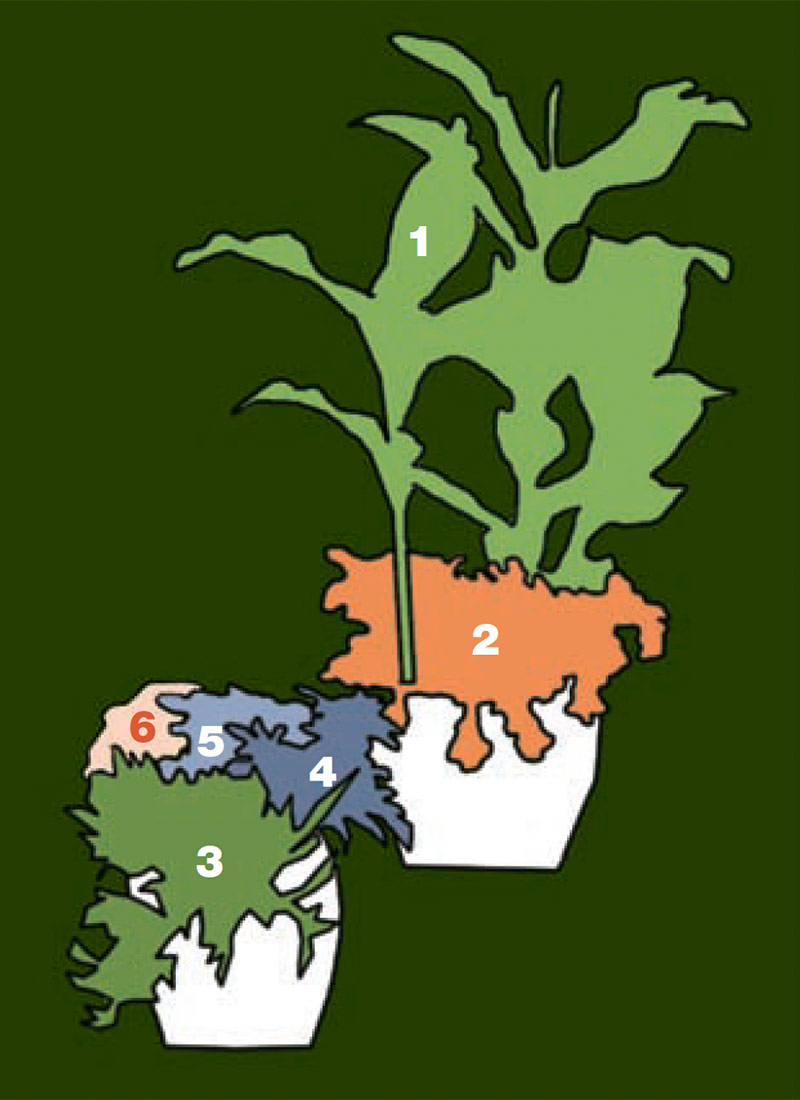

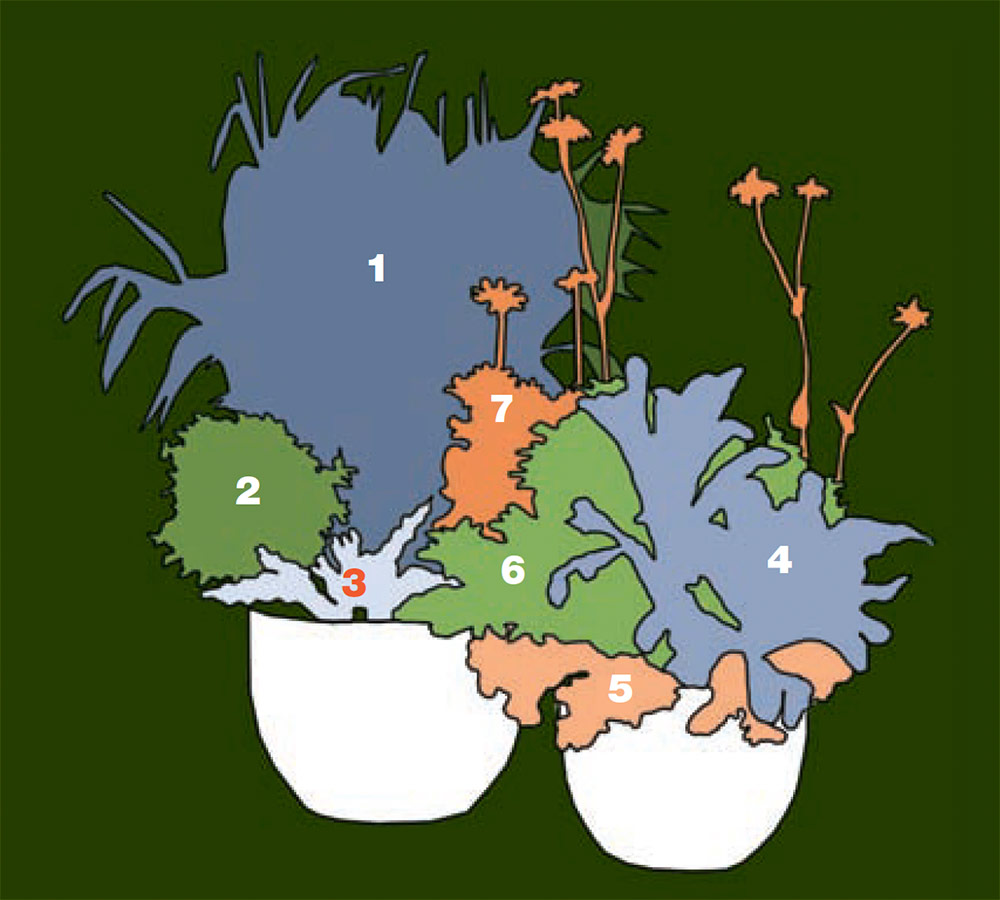


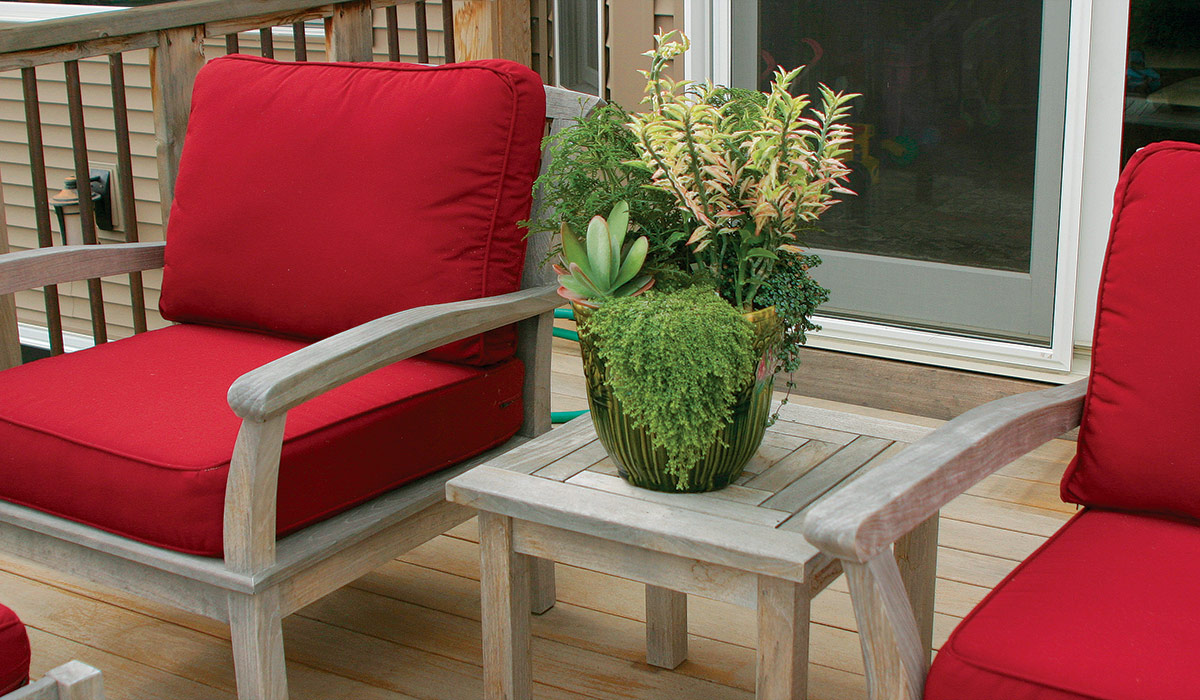





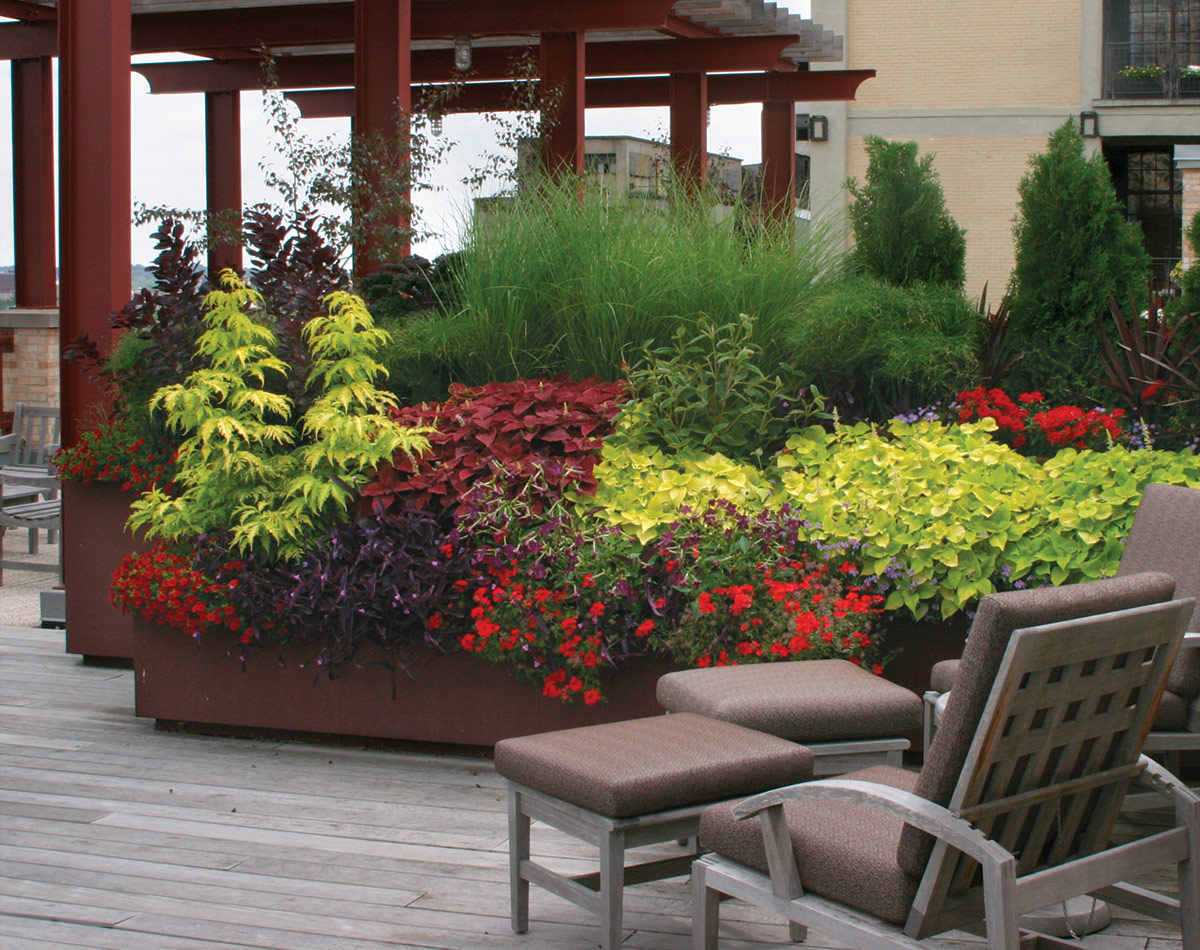


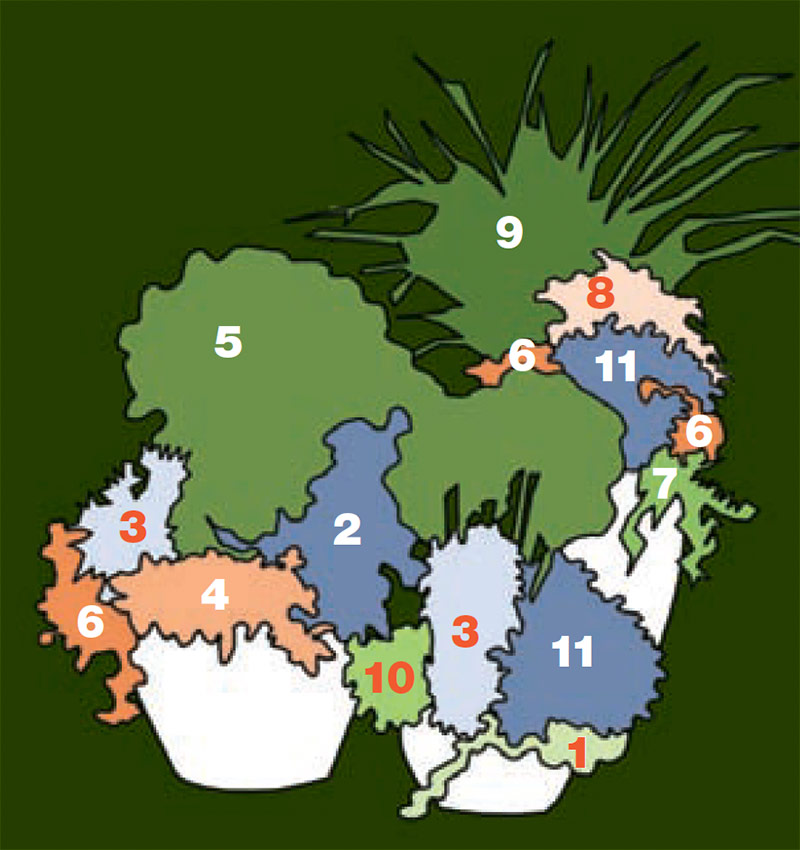
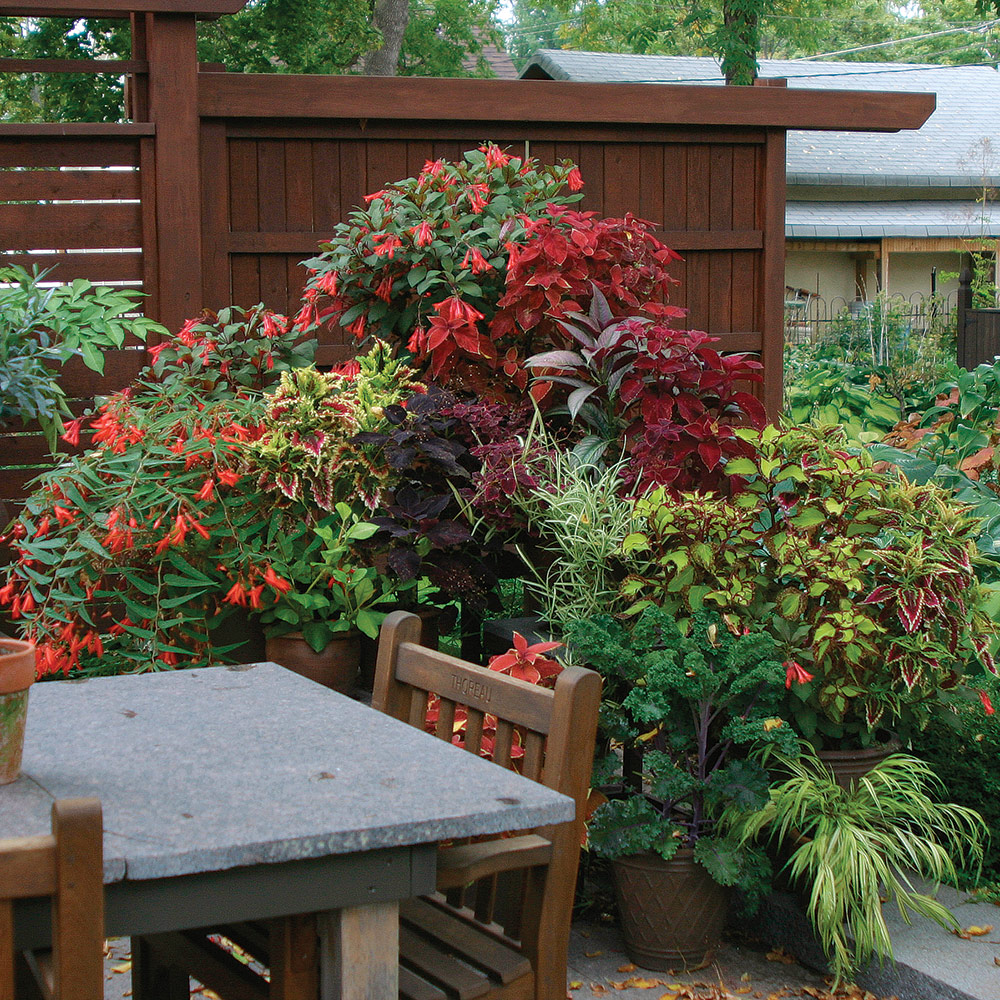
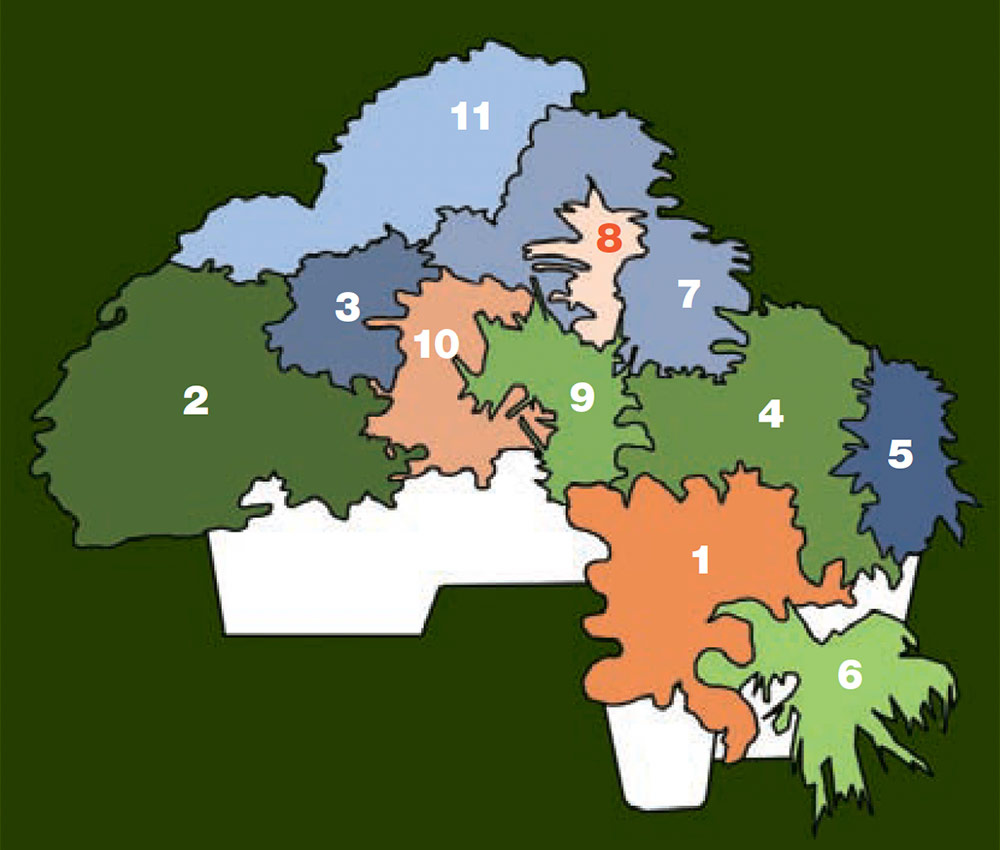
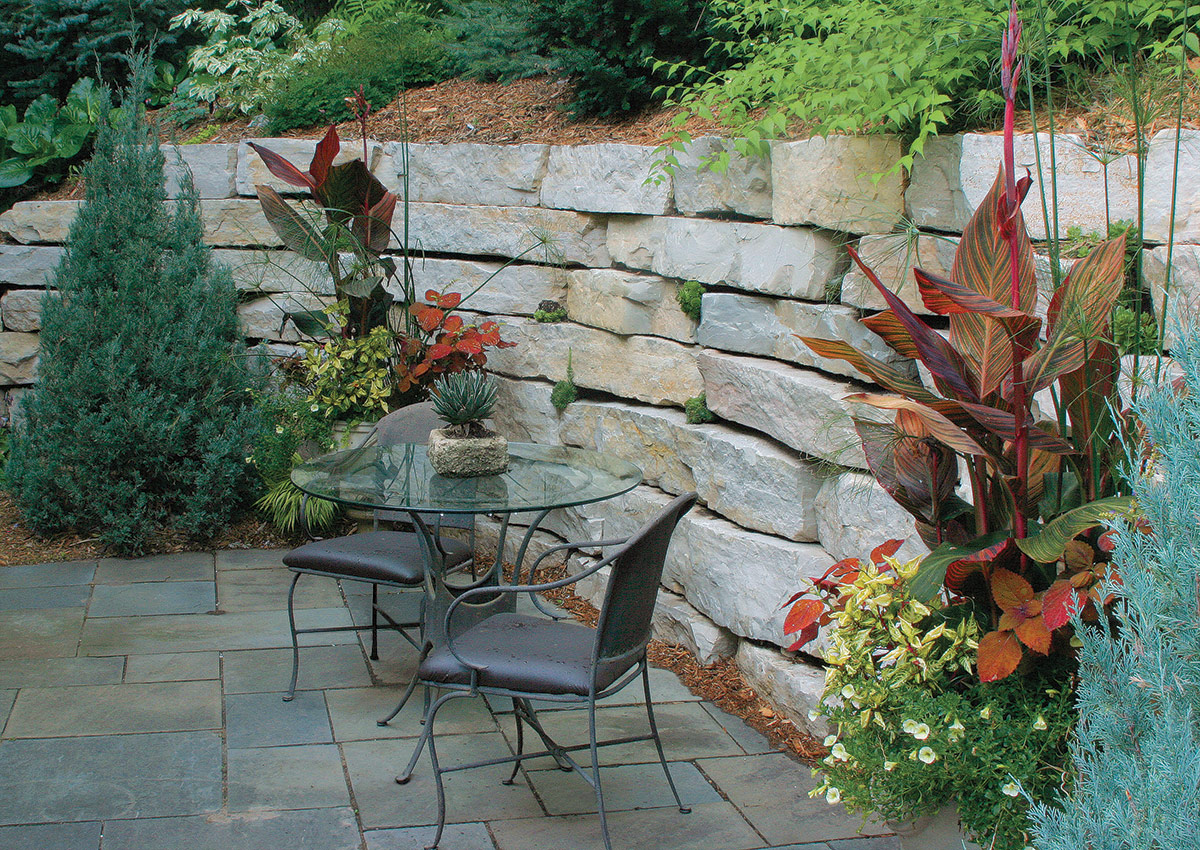




Comments
The space design of the sesame area is great. This brings creativity to the art of gardening. The architectural geometry dash lite space provides a large area of diverse flowering plants.
Log in or create an account to post a comment.
Sign up Log in